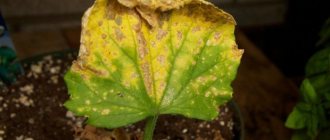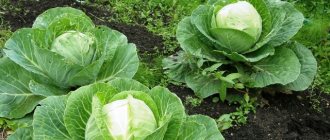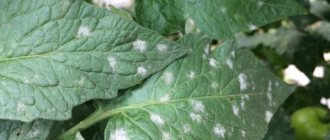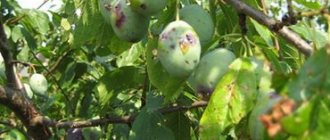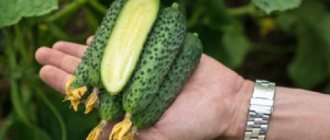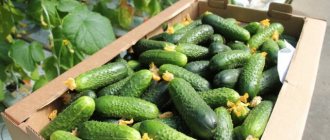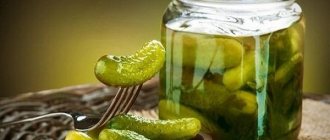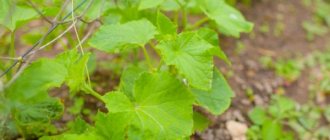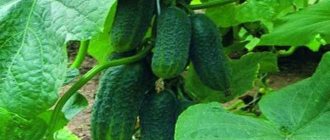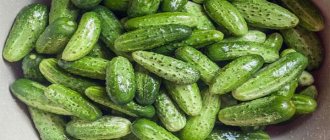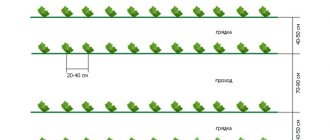Author: Natalya Category: Garden plants Published: February 28, 2019Last edits: January 6, 2021
- Causes of diseases of cucumbers in a greenhouse
- Powdery mildew on cucumbers in open ground
Beginners in gardening sometimes think that by growing vegetables in greenhouses they can avoid being affected by diseases. But that's not true. Vegetables grown indoors, with improper care and violation of agricultural conditions, suffer as often and from the same diseases as vegetables in garden beds. Therefore, once again we have to remind the truth that a disease is easier to prevent than to cure. Our article will focus on diseases that affect cucumbers both in open and closed ground. We will tell you about the most common infections of cucumber beds and how to deal with them, and most importantly, how to prevent cucumbers from becoming infected with pathogens of fungal, bacterial and viral diseases.
In addition, in this article we will answer the questions that you ask us most often. For example:
- Why do cucumber leaves turn yellow?
- what to do if cucumbers turn yellow?
- Why do cucumbers dry out?
- what to do if the cucumber leaves are covered in spots?
- How to treat cucumbers against fungal diseases?
Cucumber leaf diseases (symptoms)
Why do cucumbers dry out?
Our readers often complain that the ovaries on cucumbers dry out and fall off. This happens due to the fact that the plants do not shoot, but everything that grows from the axils of the first 3-5 leaves must be removed, and those shoots that form higher must be pinched above the second leaf.
Another reason that the ovaries turn yellow and dry out may be the density of the planting - the cucumbers do not have enough feeding area, and they are not able to grow all their ovaries.
- Cucumbers: growing from seeds in the garden
However, you should know that cucumbers always form flowers with a reserve in case unfavorable conditions arise, and when all the flowers are pollinated, the plant sheds the excess ovaries. So the drying out of part of the ovaries is a completely natural process. But what to do if the cucumbers are drying up in catastrophic quantities, and you fear for the harvest? You need to correct any mistakes you've made and hope the plants bounce back.
If large fruits begin to dry out, the reason may be that the plants are infected with the disease ascochyta.
Cucumbers also dry out due to the fact that you use manure as fertilizer during the fruiting period, although it is at this stage of development that cucumbers need phosphorus-potassium fertilizers rather than nitrogen.
The reason that cucumbers turn yellow and dry out may be the cultivation of bee-pollinated varieties and hybrids in a greenhouse instead of parthenocarpic ones.
Why do cucumbers turn yellow?
Why do cucumber leaves turn yellow? - This is perhaps one of the most frequently asked questions by site readers. And really, why do cucumbers turn yellow? And what to do if the leaves of cucumbers turn yellow? Let's look at all the reasons for this phenomenon.
If the lower leaves of cucumbers turn yellow, this may mean that the plants do not have enough light, but there is nothing wrong with that, so just tear off the yellowed leaves.
It happens that cucumbers turn yellow in open ground due to an imbalance in the water balance - either a lack or excess of moisture in the soil. Do not forget that cucumbers are a moisture-loving crop and in normal summers require watering 2-3 times a week, and in extreme heat the plants need daily moisture. But if it rains for a long time, excess moisture can lead to rotting of the roots and, as a result, we will again see yellowed leaves.
However, most often the leaves of cucumbers turn yellow due to fungal diseases - fusarium, pythiosis and others. As soon as the thirty-degree heat gives way to cold rains and the night temperature drops sharply, be prepared to fight fungi.
Cucumber leaves also turn yellow due to damage by pests - whiteflies, spider mites or aphids.
And another reason for yellowing of leaves can be a lack of nutrients in the soil: if the edges of the leaves turn yellow and dry, this means that the plant is deficient in magnesium or potassium, and dark green veins on the general yellow background of the leaves indicate a deficiency of manganese or iron . With a lack of copper, only the upper leaves of the plant turn yellow.
Well, the last reason for the yellowing of leaves on cucumbers may be a natural process - old age. Over time, the leaves become coarser, photosynthesis stops in them, they turn yellow and die.
Why do cucumber leaves dry out?
Drying of leaves on cucumbers can occur for the same reasons as their yellowing - it’s just the next stage in the development of the problem. But sometimes the leaves dry out because they are occupied by aphids or mites - turn the leaf over and look closely: if you find insects, treat the cucumbers with the insectoacaricides Aktara, Aktellik or Bazudin.
Leaves also dry out due to peronosporosis, or downy mildew, as well as from root rot caused by various fungi. Read below about how to treat these diseases.
- How to store vegetables in winter
But most often the leaves dry out for the most banal reason - due to lack of moisture. Do not allow the soil to dry out either in the greenhouse or in the garden bed, maintain the water balance at the proper level.
Why do cucumbers rot?
Cucumbers affected by gray, white or root rot rot, the development of which can be provoked by sudden temperature changes and too high air humidity.
Why do cucumber leaves turn black?
A black coating on the leaves of cucumbers may appear due to the occupation of the plant by aphids: in the course of their life, the aphid leaves honeydew on the leaves - excrement, which is a favorable environment for the sooty fungus, which covers the leaves with a black coating.
And the black mesh on the browned leaves is formed as a result of the plant becoming infected with black mold. How this disease manifests itself and develops and how to get rid of it, read in a special section.
Why do cucumbers fall off?
The same reason they dry out: because you don’t nurture them, because there are too many ovaries, because the planting is too dense and there is insufficient feeding area, because of improper fertilizing and because of some fungal diseases. Read the rules for caring for cucumbers and correct your mistakes.
Cucumber leaves wither
Plants react to all unfavorable factors primarily by the condition of the leaves, and if you notice that the leaves of your cucumbers are withering, look for the reason among those listed below:
- insufficient or untimely watering;
- insufficient distance between bushes in the garden bed;
- incorrectly chosen site - plants receive too much direct sunlight;
- errors in fertilizing - the soil is oversaturated with fertilizers or there is not enough of them;
- sudden cold snap - cucumbers are very sensitive to temperature changes;
- fusarium wilt, white or root rot, downy mildew;
- aphids or mites, or both.
All you have to do is identify the cause of leaf wilting and eliminate it.
Cucumber leaves turn white
This phenomenon can also have several reasons. For example, discoloration of leaf tips (chlorosis) may occur due to a lack of copper; aphids, herbivorous mites, or bacteriosis may be found on the leaves. But most often these are signs of diseases such as powdery mildew and white mosaic. You will read how to treat cucumbers for powdery mildew in the appropriate section, but white mosaic, unfortunately, is incurable. The carriers of this viral infection are sucking insects - aphids and mites.
Plaque on cucumber leaves
We have already found out that a black coating can form on the leaves when infected with sooty fungus or black mold. White plaque is the first sign of powdery mildew. A pinkish-copper coating is evidence of anthracnose damage to cucumbers. A white fluffy coating is a symptom of white rot, and a grayish-green (olive) coating occurs when cucumbers are infected with cladosporiosis, or brown spot.
Diseases of cucumbers in a greenhouse and their treatment
Causes of diseases of cucumbers in a greenhouse
Diseases of cucumbers in a greenhouse occur as a result of infection by the same pathogens as in open ground - fungi, viruses and bacteria. Only fungal diseases can be treated, while bacterial and viral diseases, unfortunately, are practically incurable. What violations of care conditions cause plant diseases? Why do cucumbers turn yellow in a greenhouse and what to do if the cucumbers dry out? You will learn about this in the next chapter.
Powdery mildew on cucumbers
Powdery mildew of cucumbers is one of the most common diseases in a greenhouse, which can destroy up to half the crop. The disease begins with the formation of a white coating on the underside of the leaves, and white powdery spots appear on the upper side, which gradually increase in size and darken. The leaves become deformed, twisted and die, the fruits become small and bitter, and as a result the plant withers.
Control measures: as soon as the first symptoms appear, treat the cucumbers in a closed greenhouse at an air temperature of 23-28 ºC with fungicides - colloidal sulfur, Bayleton, Topaz, Topsin-M in accordance with the instructions, repeat the treatment after 10-14 days. From folk remedies, a solution of mullein is used: 1 liter of liquid mullein and 1 tablespoon of urea are dissolved in 10 liters of warm water.
Downy mildew on cucumbers (peronosporosis)
Downy mildew, or downy mildew of cucumbers, is a very dangerous disease that mainly affects the leaves of plants: brownish-yellow round or angular spots form on their surface, growing and merging with each other, and the underside of the leaves is covered with a thick gray-violet coating. As the disease progresses, the cucumber leaves turn yellow and dry, turn brown, wrinkle, break and fall off. And in damp weather the leaves begin to rot. While you are wondering why the cucumbers in the greenhouse turn yellow, you may lose your entire crop - downy mildew is developing rapidly.
Control measures: to destroy the pathogenic fungus, cucumbers are treated with one percent solutions of Strobi, Quadris, Topaz or other fungicides. The treatment is carried out at a temperature of 22-24 ºC, after which the greenhouse should be ventilated, without allowing, however, a strong drop in the air temperature in the room.
- Horseradish: growing in the garden from seeds
Mosaic on cucumbers
In greenhouse conditions, cucumber diseases such as viral mosaics are becoming increasingly common. Viruses penetrate through the soil, damage in plant tissues, with plant debris, from contaminated equipment, and are carried by insects. The cucumber mosaic virus can also appear on seeds, but after two to three years of storage of the seed, the intensity of the virus noticeably weakens. Unfortunately, treating plants infected with mosaic virus with fungicides does not give the necessary results.
White cucumber mosaic is the most harmful form of the virus and can reduce the yield by half. The disease develops at air temperatures above 25 ºC or with sudden temperature fluctuations. The growth of the lashes slows down, and yellow and white star-shaped spots appear on young leaves, merging with each other. As a result, the leaves turn white and only the veins remain green. Few female flowers develop on diseased plants. Depressions form on the fruits, cucumbers turn yellow, and their flesh hardens.
Green mottled, or English mosaic, appears as light spots along the veins and slight wrinkling of the leaves. As the disease progresses, the growth of cucumbers slows down, the fruits become deformed and also acquire a mosaic coloring. This type of mosaic progresses with sharp fluctuations in day and night temperatures.
Control measures: it will not be possible to save a plant affected by any type of mosaic - there are no drugs against this disease yet. You can fight viral diseases by performing agricultural practices and timely implementation of disease prevention and care measures for cucumbers.
Anthracnose of cucumbers
This fungal disease is caused by the pathogen Colletotrichum lagenarium, which affects not only the leaves of cucumbers, but their stems and fruits. First, yellow spots appear on the leaves of cucumbers, which subsequently acquire a brown tint; the tissue inside the spots dies, crumbles and falls out, leaving holes. Ulcers form on the fruits - located in groups or single. In humid weather, these ulcers become covered with a pinkish-copper coating. This plaque gradually becomes more dense and darkens literally to blackness. Affected fruits become bitter and rot during storage or transportation. A pinkish coating also appears on the stems and petioles of leaves. The disease progresses at high humidity (about 90%) and air temperature within 22-27 ºC.
Control measures: at the first signs of the disease, weekly treatment of cucumbers with one percent Bordeaux mixture should be carried out. The last spraying is carried out no later than two weeks before harvest.
Rot of cucumbers
Cucumbers rot from various infections, which is why the rot has different names - white, gray and root.
Root rot spreads in soil in which cucumbers were already growing. The development of the disease is provoked by watering plants with cold water and a significant decrease in air temperature in the greenhouse. Sometimes the disease occurs due to the seedling being too deep during planting or due to improper hilling. Readers ask us: why do cucumber leaves wither? And the reason most often is the development of root rot in plants. If you free the bottom of the stem of a wilted plant from the soil, you will find that it has turned yellow and covered with cracks.
Control measures: dissolve a teaspoon of copper sulfate and three tablespoons of wood ash in 0.5 liters of water, mix thoroughly and apply this mixture with a brush to the stem of the plant from the root 12 cm up. Water the cucumbers in the morning with warm water at the roots. Remove the dead plants along with the earthen lump, and spill the soil in which they grew with a solution of a tablespoon of copper sulfate in 5 liters of water.
Gray rot, or botrytis, appears as gray mucous spots in the axils of leaves near the branches. The infection develops against the background of a sharp drop in night temperature, watering with cold water, too dense planting and poor air exchange. Gray rot stimulates the development of a large number of male flowers, which quickly wither. It is advisable to remove this barren flower immediately.
Control measures: sprinkle the affected areas with a mixture of a glass of wood ash and a teaspoon of copper sulfate, and if there is no result, the diseased plants should be removed and burned, and the soil should be shed, as in the case of root rot.
White rot on cucumbers, or sclerotinia, is more common than root and gray rot. The disease affects leaves and their petioles, stems and fruits of cucumbers. The waste products of the fungus kill plant cells - the tissue becomes slimy, a fluffy white coating forms on the ground parts, in which sclerotia - black dots - form over time. Affected tissues rot.
Control measures: at the early stage of the lesion, the sore spots are treated with a mixture of potassium permanganate solution and chalk, but if the disease has taken hold, it is better to remove the plant. Among the fungicides against white mold, Rovral SP, Euparen multi SP and Oksikhom can help.
Cucumber spotting
Spots on the leaves of cucumbers can cause the diseases bacteriosis (angular spot) and brown (olive) spot - cladosporiosis.
Bacteriosis can be detected already on the seven lobes - small light brown spots or ulcers appear on them. Then angular, oily or weeping spots, gradually turning brown, appear on the leaves, bounded by veins. With high humidity, cloudy liquid collects in drops on the underside of the leaves under the spots. As the disease progresses, the tissues in the spots dry out and die, leaving holes in the leaves. The fruits of cucumbers are also affected by deep ulcers, as if bitten by birds, from which, like leaves, exudate flows in wet weather, and a whitish crust forms on them in dry weather. Bacteriosis develops at a temperature of 19-24 ºC.
Control measures: at the first manifestations of bacteriosis, the leaves of the plant are watered with a solution of Fitosporin-M, and after two weeks the treatment is repeated.
Brown (olive) spot. Cladosporiosis affects both the leaves and stems of the plant and its fruits with spots: watery spots form on them, quickly growing in breadth and depth. The cucumber peel cracks in these places and releases a drop of gelatinous liquid, which immediately hardens and separates. With increased air humidity, a grayish-green velvety coating appears in areas affected by cladosporiosis, the spots merge and form ulcers surrounded by a chlorotic zone. If the disease affects the plant at an early stage of development, then you can observe how the cucumber ovaries become deformed, stop developing and turn yellow.
Control measures: at the first symptoms of spotting, the cucumbers should be treated with fungicides - Rovral, Ridomil, Falcon or similar preparations.
Black mold of cucumbers
If cucumber leaf diseases develop only on leaf blades and petioles, then black mold can affect all above-ground parts of the plant. At first, small round spots appear, but after a short period of time you find brown leaves on the cucumbers, which are covered with a black web of plaque. Sharp changes between day and night temperatures provoke the development of black mold.
Control measures: the sooner you detect the disease and take measures to destroy its pathogens, the greater your chances of saving the plants. The pathogens of the disease are destroyed by two-stage treatment of cucumbers with one percent Bordeaux mixture with an interval of 7-10 days.
Fusarium blight on cucumbers
This fungal disease is manifested by wilting of individual leaves and stem tips. As the disease progresses, the stem begins to rot in the area of the root and root collar. Infectious agents are activated by high soil and air humidity.
Control measures: unfortunately, fungicidal preparations are not able to cope with fusarium wilt, and it can only be combated with preventive measures that will help you prevent cucumbers from becoming infected with fusarium.
Ascochyta blight of cucumbers
Ascochyta blight affects both adult plants and cucumber seedlings. Weeping spots with numerous black dots - pycnidia - appear on the basal part of the stems of seedlings. Then a constriction forms at this place. In adult plants, where the petioles attach to the stems, dry areas appear, almost black from a large number of pycnidia. Around these areas, the stems become dry, whitish, then crack and become macerated. Yellow-brown spots appear on the leaves, becoming lighter over time, becoming covered with pycnidia and merging with each other. The greens are cooked like boiled ones, but they do not become soft, but begin to dry out. The disease progresses with high air humidity, primarily affecting weakened specimens.
Control measures: if signs of the disease are detected, carry out a cycle of treating cucumbers with one percent Bordeaux mixture at intervals of 7-10 days.
Diseases of cucumbers in open ground
Diseases of cucumbers in open ground have the same symptoms as diseases of greenhouse plants, so we will not describe their symptoms again, but will only talk about methods of combating diseases in open ground conditions. But we will describe diseases of cucumbers that do not occur in greenhouse conditions and their treatment in more detail.
Powdery mildew on cucumbers in open ground
Control methods: at the first signs of the disease, it is necessary to treat the beds with mullein infusion, and repeat the spraying after ten days. In case of local damage, it is necessary to cut off and destroy diseased leaves and stems with fire or wipe the affected areas with a cotton swab with ground sulfur. Treatment of cucumbers and soil on the site with a solution of 20 g of colloidal sulfur in 10 liters of water is effective. Instead of colloidal sulfur, 7 g of copper sulfate and 100 g of liquid soap can be dissolved in 10 liters of water. Cucumber beds are treated with these solutions every week. If you are faced with a particularly resistant form of the fungus, you will have to treat the cucumbers with Falcon, Hom or Topsin-M in accordance with the instructions.
Downy mildew (peronospora) in open ground
Control methods: treatment of cucumbers for peronosporosis at the first minor manifestations should be carried out with a one percent urea solution or a milk-iodide solution (1 liter of skim milk is poured into 9 liters of water and 10 drops of iodine are added). Bordeaux mixture or copper oxychloride solution copes well with the disease. In critical cases, cucumbers are treated with Ordan or Ridomil fungicides.
Anthracnose (scarp) on cucumbers in open ground
Control methods: if symptoms of anthracnose occur, all affected areas should be treated with copper sulfate (0.5%), then sprinkled with crushed charcoal or lime. It is necessary to treat cucumbers weekly with one percent Bordeaux mixture. Stop spraying a week before harvest.
Mosaic on cucumbers in open ground
In open ground, cucumbers are affected by the green speckled mosaic, which we wrote about, and the common mosaic, a virus that affects up to 800 plant species and can destroy half the crop. The pathogen may appear on cucumbers already during the seedling period in the form of spots and pimples on the leaves of seedlings. As a result of the development of the disease, cucumber leaves shrink, their area is significantly reduced, as is the process of photosynthesis in them.
Control methods: it is impossible to defeat these diseases - diseased plants will have to be removed and burned. The disease must be combated by preventive measures and by preventing virus carriers – sucking insects – from entering the area with cucumbers.
Rot of cucumbers in open ground
Control methods: in order to combat the spread of gray rot, it is necessary to remove all heavily affected plants, and for those that are partially affected, the diseased leaves should be removed and a mixture of chalk and potassium permanganate of a light pink hue with a viscous consistency should be applied to the wounds.
At the early stage of development of root rot, you need to expose the lower part of the stem and the upper part of the root system and sprinkle the rot-affected areas with a mixture of charcoal, chalk and ash. If the damage is severe, treat the area with a solution of copper sulfate or copper oxychloride according to the instructions.
White rot most often develops in a greenhouse, but can also occur in open ground. Remove diseased leaves on a hot, dry day - this will help the wounds dry out faster. Wipe the cut areas with a 0.5% solution of copper sulfate and sprinkle with crushed coal.
Spotting of cucumbers in open ground
In open ground, as well as in protected ground, cucumbers can develop spots.
Control methods: in order to combat bacteriosis (angular spotting), a two-stage treatment of cucumbers with seven percent Bordeaux mixture is carried out - when the disease manifests itself on the cotyledons and when signs of spotting appear on real leaves.
Cucumbers are also treated with the same product in case of brown (olive) spot or cladosporiosis.
Ascochyta blight on cucumbers in open ground
The methods for combating ascochyta blight in open ground are the same as for spotting - treating cucumber beds with one percent Bordeaux mixture. Spraying is carried out at intervals of a week, but the last treatment is carried out no later than a week or two before harvest.
Fusarium on cucumbers in open ground
As in a greenhouse, treating plants with fungicides will not give any results. Fusarium wilt can be combated only by preventive measures - treating the soil before planting cucumbers with biofungicides Trichodermin or Fitosporin-M, for example.
Black mold on cucumbers in open ground
Control methods: black mold, or burn of cucumber leaves, is treated at an early stage with fungicides - Bordeaux mixture, copper sulfate, copper oxychloride and other drugs, but first the rusty leaves on cucumbers with black mesh mold are cut off. In case of severe damage, diseased plants are completely destroyed.
Rhizoctonia of cucumbers in open ground
This harmful disease affects plants both in the greenhouse and in open areas. As a result of the development of the disease, you can lose all planting material. The main source of infection is soil. All above-ground parts of the plant are affected, except the flowers: spots form on the leaves, and small sores appear on the fruits.
Control methods: to destroy the pathogen, the soil is treated with Trichodermin or Fitosporin-M, and the cucumbers are sprayed with copper oxychloride or Ridomil Gold.
Growing cucumbers in open ground - planting and care
Preventive measures
Fighting diseases is a difficult process that causes a lot of trouble and takes time.
Important! To preserve the harvest, follow agricultural practices and carry out disease prevention in a timely manner.
Whey diluted in water and heated in a ratio of 1:7 effectively acts as a prophylaxis. Also, if you put two handfuls of onion peels in a bucket of water, boil for half an hour, wait for the solution to cool, strain and dilute with water in a ratio of 2:1, you will get an effective mixture, which is periodically watered with cucumbers from a watering can.
Prevention of cucumber diseases
Diseases of cucumbers and the fight against them are described in specialized literature and on many websites, but, nevertheless, this topic is still relevant due to the fact that cucumbers continue to get sick, and gardeners prefer to fight diseases, although with less significant efforts it is possible these diseases were prevented. To do this, you just need not to be lazy and not neglect preventive measures, which include agrotechnical, biological and chemical methods of protection.
Agrotechnical methods include:
- removal of plant residues from the site and deep digging of the soil after the end of the season;
- treatment and disinfection of soil before planting;
- maintaining the most favorable microclimate for the crop in the greenhouse;
- treatment of the greenhouse at the end of the season and disinfection before planting;
- processing and dressing of seeds before sowing;
- use of disease-resistant varieties and hybrids;
- compliance with crop rotation.
For biological protection of plants from diseases, the cultural liquid Trichodermin is used:
- 80 ml of the drug is dissolved in 10 liters of water to treat plants against rot, fusarium, bacteriosis and powdery mildew;
- for pre-sowing treatment of seeds - at the rate of 20 ml of the drug per 1 kg of seeds;
- for adding to the nutrient mixture when sowing in the amount specified in the instructions;
- as an additive to a clay mash for treating the root system of seedlings at the rate of 5 ml of the drug per 1 plant;
- for adding into holes when planting seedlings in a permanent place - the consumption rate is 5 ml of the drug per 1 plant;
- for watering plants - the consumption rate is 100 ml per 10 liters of water;
- for preventive spraying of plants once every 10-20 days from the moment two true leaves develop - the consumption rate is from 100 to 300 ml per 10 liters of water.
The biological drug Planriz is also used for the same purposes:
- for treating cucumbers against powdery mildew, spots and rot with a solution prepared in accordance with the instructions;
- for pre-sowing treatment of seeds - a day before sowing, they are kept in a one percent solution of the drug;
- for adding into holes when planting seedlings - at the rate of 0.5 ml per bush;
- for treating plants during the growing season and for preventive treatment every 2 weeks (0.5 percent solution).
Chemical protection of cucumbers from diseases is carried out with fungicides - Bordeaux mixture, copper sulfate, colloidal sulfur, copper oxychloride, as well as the preparations Ridomil Gold, Bravo, Quadris, Topsin-M and Topaz. These drugs are used in strict accordance with the instructions.
Timing and frequency of treatments
Bordeaux mixture is used to combat fungal diseases. The treatment is repeated 3-4 times, every 10 days. Fungicides are applied at the first symptoms, twice, with a break of 7 days.
During planting, cucumbers are watered with Alirin-B + Gamair. 2 tablets per 10 liters of liquid. The mixture improves the plant's immunity.

